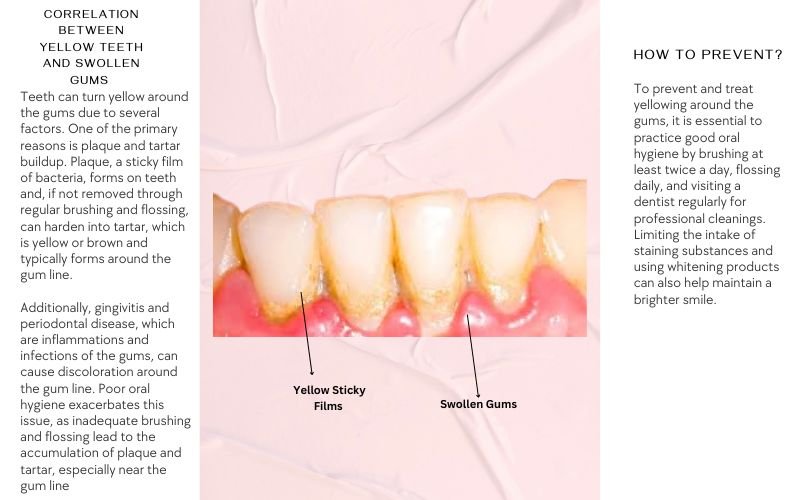In the realm of personal aesthetics, a radiant smile holds significant sway. The allure of pristine, white teeth and healthy gums is universally acknowledged. Yet, the reality for many includes the presence of yellow teeth accompanied by swollen gums, a condition that often raises both concern and curiosity. Understanding the causes behind this common yet troublesome issue, such as gingivitis and yellow teeth, is essential for maintaining oral health and overall well-being.
Anatomy of Teeth and Gums
To comprehend the complexities of yellow teeth and swollen gums, one must first delve into the anatomy of these vital oral components. Teeth, composed primarily of enamel and dentin, are designed to withstand the rigors of daily use, while gums, or gingiva, serve as the supportive tissue anchoring the teeth in place. The interplay between these structures is crucial for maintaining a healthy mouth; any disruption can lead to significant dental issues.
The tooth’s root extends into the jawbone and is covered by cementum, which helps anchor the tooth to the periodontal ligament. This ligament acts as a shock absorber during chewing and biting, preventing damage to the bone. The inner part of the tooth, the pulp, contains nerves and blood vessels, providing nourishment and sensory function.
Gums are made of dense, fibrous tissue that acts as a barrier against bacteria and other pathogens. Healthy gums are pink and firm, creating a tight seal around the teeth to protect the underlying bone and roots. Any breach in this seal can lead to infections, which, if left untreated, may progress to more serious conditions affecting overall oral health.

Common Causes of Yellow Teeth
Teeth yellowing is a multifactorial issue, stemming from both intrinsic and extrinsic factors. Inherent causes include natural aging, genetic predispositions, and enamel formation illnesses.
- Extrinsic factors are often more controllable, such as the consumption of staining substances like coffee, tea, and tobacco. Additionally, inadequate dental hygiene practices can exacerbate discoloration, leading to a less-than-ideal smile.
- Another significant factor is using certain medications, such as tetracycline antibiotics, which can cause intrinsic staining if taken during tooth development. Fluorosis, caused by excessive fluoride intake, can also lead to discoloration. Preventive measures include limiting exposure to these risk factors and adopting good oral hygiene habits.
- Diet plays a crucial role in maintaining teeth’s natural whiteness. Foods high in sugar and acid can erode enamel, making teeth more susceptible to staining.
- Regular consumption of crunchy fruits and vegetables, which stimulate saliva production and help clean teeth, can mitigate these effects and promote a healthier smile.
Understanding Gum Swelling
Gum swelling, clinically known as gingival swelling, is an inflammatory response often indicative of underlying oral health problems. In more severe cases, this condition can be triggered by bacterial infections, known as gingivitis or periodontitis. Other potential causes include hormonal changes, particularly during pregnancy, as well as allergic reactions to dental products or food. Recognizing the signs of gum swelling is pivotal for timely intervention and treatment.
In some cases, poor oral hygiene can lead to the accumulation of plaque, a sticky film of bacteria, on the teeth and gums. If not removed, plaque can harden into tartar, further irritating the gums and exacerbating inflammation. Regular brushing, flossing, and professional cleanings are essential to prevent these issues.
Nutritional deficiencies, such as a lack of vitamin C, can also contribute to gum swelling and bleeding. Ensuring a balanced diet of essential vitamins and minerals supports gum health. Additionally, managing systemic conditions like diabetes, which can affect gum health, is crucial in preventing and controlling gingival swelling.
Correlation Between Yellow Teeth and Swollen Gums
The simultaneous occurrence of yellow teeth and swollen gums is frequently interlinked, with each condition potentially exacerbating the other. Poor oral hygiene practices, such as inadequate brushing and flossing, can lead to plaque buildup, which in turn causes both teeth staining and gum inflammation.

Additionally, certain lifestyle choices and health conditions can simultaneously impact the appearance of teeth and the health of gums, creating a cyclical pattern of oral health issues.
- Systemic diseases like diabetes can further complicate the correlation between these conditions. Diabetes can impair blood circulation, reducing the body’s ability to fight off infections, including those in the mouth. Thus, it increases the risk of gum disease and makes teeth more susceptible to discoloration. Additionally, medications taken for various health conditions can cause dry mouth, reduce saliva flow, and allow bacteria to thrive, affecting both teeth and gums.
- Stress is another factor that can negatively impact oral health. High-stress levels can lead to poor dietary choices and neglect of oral hygiene routines. Stress also increases the production of cortisol, a hormone that can cause inflammation throughout the body, including the gums. This inflammation, coupled with weakened immune responses, can exacerbate both tooth yellowing and gum swelling.
Impact of Poor Oral Hygiene
Neglecting oral hygiene primarily contributes to yellow teeth and swollen gums. Plaque, a sticky film of bacteria, accumulates on teeth and along the gumline, leading to tooth discoloration and gum disease. Failure to remove plaque through regular brushing and flossing allows it to harden into tartar, further aggravating these conditions. Consistent and thorough oral care routines are indispensable for preventing these common dental problems.
In addition to brushing and flossing, antibacterial mouthwash can help reduce plaque and bacteria in the mouth, thus preventing gum disease and maintaining teeth’ natural whiteness. Regular dental check-ups are also crucial, as professional cleanings can remove tartar that at-home care cannot address, and dentists can provide personalized advice for maintaining optimal oral health.
Maintaining oral hygiene can be challenging but equally important for individuals with braces or other orthodontic appliances. Special tools like interdental brushes and water flossers can assist in cleaning hard-to-reach areas, ensuring that both teeth and gums remain healthy and free from discoloration and inflammation.
Influence of Diet and Lifestyle Choices
Diet and lifestyle choices play a significant role in the health and appearance of teeth and gums.

- Frequent consumption of acidic and sugary foods and beverages can erode enamel and promote bacterial growth, leading to yellow teeth and gum inflammation.
- Smoking and tobacco use are particularly detrimental, staining teeth and impairing gum health.
- Conversely, a balanced diet rich in vitamins and minerals supports oral health, contributing to a brighter smile and healthier gums.
- Incorporating foods high in calcium and phosphorus, such as dairy products, nuts, and leafy greens, can strengthen enamel and protect against decay.
- Foods rich in vitamin C, like citrus fruits and strawberries, help maintain healthy gums by boosting collagen production and fighting off bacteria.
- Drinking plenty of water throughout the day can also help wash away food particles and bacteria, reducing the risk of tooth staining and gum disease.
- Limiting the intake of caffeinated beverages, such as coffee and tea, can also reduce staining and prevent dry mouth, which can exacerbate gum issues.
Adopting these dietary changes and avoiding harmful habits like smoking can significantly improve the appearance and health of teeth and gums, leading to a more confident smile and better oral health.
Medical Conditions and Medications
Certain medical conditions and medications can adversely affect dental health, leading to yellow teeth and swollen gums. Conditions such as diabetes and autoimmune diseases can impair gum health.
At the same time, medications like antihistamines, antidepressants, and blood pressure drugs can reduce saliva production, fostering an environment conducive to bacterial growth. Awareness of these potential side effects is crucial for managing overall dental health.
Osteoporosis and its treatments can also impact oral health, weakening the jawbone and increasing the risk of tooth loss and gum disease. Additionally, chemotherapy and radiation treatments for cancer can lead to dry mouth, sores, and increased susceptibility to infections, all of which can exacerbate issues with yellow teeth and swollen gums
Preventive Measures and Treatments
Prevention and treatment of yellow teeth and swollen gums involve a multifaceted approach. Regular dental check-ups and professional cleanings are essential for maintaining oral health and addressing early signs of problems. At-home care, including proper brushing, flossing, and the use of mouthwash, can significantly reduce the risk of these conditions. Additionally, lifestyle modifications, such as reducing the intake of staining substances and quitting smoking, can profoundly impact oral aesthetics and health.
Incorporating whitening toothpaste and over-the-counter whitening products can help manage mild cases of tooth discoloration. In contrast, more severe cases may benefit from professional whitening treatments provided by a dentist. For gum health, using a water flosser can help remove debris and bacteria below the gumline, enhancing oral hygiene. By combining these practices with regular professional care, individuals can effectively prevent and treat yellow teeth and swollen gums, maintaining a healthy and attractive smile.
Conclusion
A smile marred by yellow teeth and swollen gums can be a source of discomfort and self-consciousness. However, understanding the causes and adopting effective preventive measures can significantly mitigate these issues. Individuals can achieve a healthier, more radiant smile by maintaining diligent oral hygiene, making informed dietary choices, and seeking regular professional care.

Dr. Orion Johnson is a dedicated and compassionate dentist committed to providing exceptional dental care to his patients.Dr. Johnson obtained his Doctor of Dental Surgery (DDS) degree from a prestigious dental school, where he excelled academically and clinically. He is licensed to practice dentistry and stays updated with the technology through continuing education and training.
